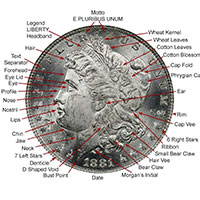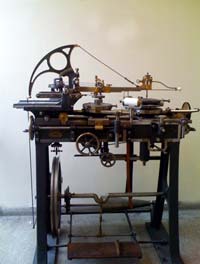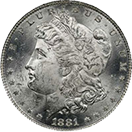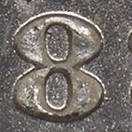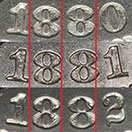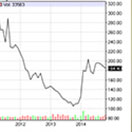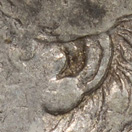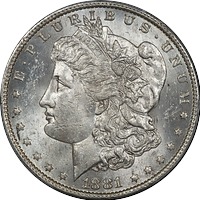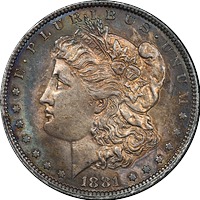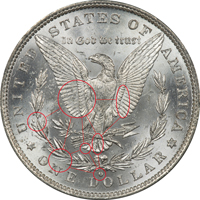
January 2017 - Welcome
Sources
Search
Contact
Home
Welcome
Click on year to expand
2022
2021
2020
2019
2018
2017
2016
2015
Welcome
Wanted Alive Not Dead
New Year's Resolution
![]() We had a new 40 coin submission in to VSS and those coins were added to the web site in late December. In the group were two VAM 5 - O/O, Doubled Right 1; one VAM 1D - Flaky Eye; and two VAM 27 - Doubled Ear coins. So this is a nice batch for adding to the most desirable VAMs.
We had a new 40 coin submission in to VSS and those coins were added to the web site in late December. In the group were two VAM 5 - O/O, Doubled Right 1; one VAM 1D - Flaky Eye; and two VAM 27 - Doubled Ear coins. So this is a nice batch for adding to the most desirable VAMs.
Also included in this group were two Poor 01 and one About Good 03 coins. We knew that VAMing them would be a long shot, but we tried. But with the addition of the two Poor 01 coins we now hold 60% of that PCGS graded group.
You can see the whole submission by clicking here.
![]()
![]() In late October we finished up raw coins for a bulk submission by VSS to PCGS. We were not expecting that submission to come back until January, but in mid December it showed up. Of the 100 coins submitted, 74 graded. We submitted several coins that we thought were on the edge of grading so the success ratio was pretty good.
In late October we finished up raw coins for a bulk submission by VSS to PCGS. We were not expecting that submission to come back until January, but in mid December it showed up. Of the 100 coins submitted, 74 graded. We submitted several coins that we thought were on the edge of grading so the success ratio was pretty good.
The coins returned from VSS just before Christmas and will be posted as soon as the images arrive. There are a few in this group we will be sending to LVA for analysis, so hopefully we will start off 2017 with a new discovery or two.
![]()
![]() Sometimes we swear that there is collusion in the market when we start looking for a particular VAM. As noted above we are working to expand our VAM 5 inventory. But no sooner that we started working on that VAM, the raw coins dry up.
Sometimes we swear that there is collusion in the market when we start looking for a particular VAM. As noted above we are working to expand our VAM 5 inventory. But no sooner that we started working on that VAM, the raw coins dry up.
We also swear that coins seem to come in spurts. We will see many clashed coins at once and then they dry up. Then in the latter part of November and early December several VAM 1D coins suddenly appeared on eBay, all circulated at various grades. Then there was a PCGS graded one on Great Collections and another on Heritage. Maybe VAMs somehow flock together? Whatever the reason they are in season, so while we wait for VAM 5 coins, we are scooping up VAM 1Ds.
See our notes on the right for more on the 1D.
VAMs 24.2 and 71
Working through VSS and the discoverer of two new VAMs, 24.2 and 71, we were able to acquire the two discovery coins and add them to our collection. It is great to have others working on this narrow project and continues to illustrate the value of our approach.
The two VAMs are a Die 2 for preexisting VAM 24 - Doubled Second 1. The original VAM 24 Die 1 discovery is credited to Martin Field in 1982. This new die is credited to Jim Longe.
The second is a new VAM 71 - Doubled 18-1, Legend, and Left Wreath and this new VAM is also credited to Jim Longe.
Both of these coins were in the VSS batch mentioned above and we now have the images and they have been posted to the web site and at VAMworld.
 You can read more about these two VAMs in the right hand column, but these are becoming the Holy Grail of the 1881-O series. If you remember the movie City Slickers and Jack Palance's role as Curly, then you might remember his note about the secret of life. According to Curly you have to remember that "The main thing is to remember to keep the main thing the main thing."
You can read more about these two VAMs in the right hand column, but these are becoming the Holy Grail of the 1881-O series. If you remember the movie City Slickers and Jack Palance's role as Curly, then you might remember his note about the secret of life. According to Curly you have to remember that "The main thing is to remember to keep the main thing the main thing."
We have no interest in taking credit for the find. The "main thing" is to find them.

So in the spirit of good old Curly we are going to offer a prize of $100 to find either or both of these two VAMs. So if you happen to run into one at a show or on-line please keep this challenge in mind. Since lack of documentation is an issue for these two we will work with VSS to have them labeled and photographed.
VAM 1D Study Continues
We believe that we have located several very early state of the VAM 1D Pummeled "Flaky" Eye. Although we want some additional confirmation from VSS, the coin has all the trade marks of the right VAM.
If we are right then the deterioration of the area just above the eyelash is just beginning to cave in, and the "spider veins" across the eye and nose are also just beginning.
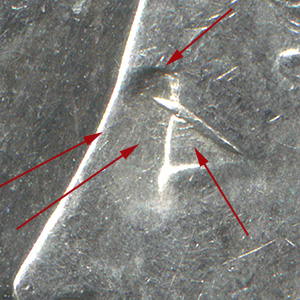
Although we will wait on final confirmation from VSS and PCGS we think this is a bit of a coup in learning how the Flaky Eye evolved. For now it seems that the error did not just occur from damage, but that the die slowly deteriorated in some way.
In July we found a similar proof-like coin without the usual deterioration and this coin can potentially be either proof like or deep mirror proof like. So the development of the error and the progression of the die state may be illustrated if we can just find enough of them.
But for sure there are die states in addition to grade states to study if we can locate them.
A Major Milestone
We are almost there, and with the addition of the coins in the bulk submission we will cross the next inventory milestone. You can see at the top of this page that our inventory count is at 599 and that is far beyond where we thought we would be when we started this venture. But with help from several friends and experts we have cornered at least one example of 88% of the 1881-O series.
Hopefully 2017 will lead to even more discoveries and filling a few more of those final gaps.
The Missing VAMs
Someone asked the question on VAMworld about New Year's resolutions and we responded that we want to continue our full court press on VAMs 21 and 29. So here are the details of these two elusive ladies.
![]() VAM 21 - O/O Top Right
VAM 21 - O/O Top Right
We discovered quite by accident that the discovery coin is listed on the SSDC site as an MS 64 ICG certified coin. So far as we can tell no one has come forward with another certified copy of VAM 21 since its discovery back in 1980 by Martin Field. We do not doubt the existence of the VAM 21, only that no one has documented a second one in 36 years.
Since there is no photographic evidence of the discovery coin, through VAM 10 you can at least know part of what to search for when looking. VAM 21 shares a reverse with VAM 10, yet the obverse lacks the date doubling or tripling of the VAM 10. They are two different die parings where the VAM 21 has Die 1, and VAM 10 has Die 5. Adding to this hope is that on VAM 21 the missing die pairing is Die 1, not some obscure die that has only been seen once.
So when looking for VAM 21 we know where to start. You go on a path through VAM 10 and work until you find that reverse paired with Die 1. In the picture above some of the visual clues to Reverse Die h are identified and we believe just a "brute force" attack on coins with Reverse Die h may produce a VAM 21 coin. If not then we are going to have a lot of VAM 10 coins to produce some study!
![]()
VAM 29 - Doubled 18 and Stars
But VAM 29 is a totally different challenge, and we are not sure it can be found, and here is why.
VAM 29 was discovered by Herbe Zepke back in 1998, which does not seem so long ago, but it was 19 years back. Like the VAM 21 no one has come forward to document owning another one. We do not doubt the existence of the discovery coin, only that it cannot now be examined and no one seems to know where the coin resides.
Further complicating VAM 29 is that there is no known photographic evidence of the discovery coin. Without either the coin or photographic evidence comparison to later discoveries cannot be made to know if VAM 29 was superseded by later VAM discoveries.
Then there are die issues with VAM 29. The VAM has obverse Die 18, and reverse Die a. Now reverse Die a could be a clue to finding the coin if it were any other die. But Die a is shared by so many other VAMs that it becomes useless in identification.
So we would then turn to the obverse die to find associations. But for VAM 29 the obverse die is Die 18, which seems to be shared with no other VAM. So we cannot go to the photographic evidence for shared dies to find a starting point for our search, nor can we do any comparison with later discoveries to determine if there was overlap with other VAM discoveries.
![]()
Resolving this issue is not easy. It can be more difficult to "kill" a VAM than to make one for a number of good reasons.
- First, just because you cannot find one does not mean it doesn't exist, only that you may not have looked long and hard enough.
- Second, we know that a discovery coin did exist that was examined and identified with the unique die pairings to produce VAM 29.
PCGS Price and Value Analysis
2016 Year End Inventory
We annually do an analysis of PCGS stated values and finished it up early this year.
The comparison between 2016 and 2015 populations, prices, and values can be accessed by clicking here.
There has been a good deal of conversation on the VAMworld message board about the softness of prices in the world of coins. But our analysis would indicate that at least for the 1881-O this is not true. We don't think there has been any appreciation, but neither has there been any degradation of prices in the aggregate.
For the year the number of graded coins increased by 6% and the aggregate value of all graded coins increased by 5.9%. One might want to argue about the accuracy of pricing, but this is always a bone of contention. Assuming that PCGS used the same pricing criteria in 2015 and 2016, then this argument would not seem to "hold water."
Like it or not; believe it or not; values seem to have stayed stable so far as we can tell.
As we close in on a full set of VAMs for the 1881-O our need to stay in some reasonable price range becomes obvious from this chart. Like the PCGS inventory at large, our "sweet spot" is in the MS62 and MS63 range where there is good detail and reasonable prices. We also set a goal for ourselves of maintaining an inventory of 1% of the PCGS graded coins at each grade, and we are on track to meet that objective. The bulk submission in the works now will skew these figures toward the AU rated coins, but will not hurt our overall goals.

2016 Year End Web Site Data
First PCGS MS65+DMPL
Well the stats are in for 2016 and we like what we have seen. Our objective is to promote VAMing and in some small way we think we are at least making a dent. Our thanks to all who have visited and for the positive comments. So as to the data this is what happened.
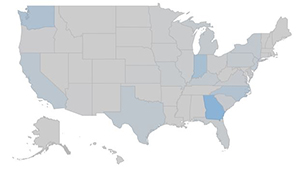 Here in the United States we received at least one visit from every state. Activity was focused more in the South (Georgia, Texas, and North Carolina) and far West (California and Washington). But there was also good activity in the Mid-west.
Here in the United States we received at least one visit from every state. Activity was focused more in the South (Georgia, Texas, and North Carolina) and far West (California and Washington). But there was also good activity in the Mid-west.
There were 2,294 unique visitors who visited a total of 9,212 times. But more importantly for us is that they viewed 438,154 images. So there is excellent evidence that our VSS images are a significant resource for those who visit.
 Worldwide the information is encouraging, but we are always a little suspect of the traffic from a few places. Setting aside that bias, there were visits from 93 different countries, excluding the United States. Outside the US there were another 2,080 visitors who stopped by a total of 7,081 times. From outside the US there were 76,699 image views.
Worldwide the information is encouraging, but we are always a little suspect of the traffic from a few places. Setting aside that bias, there were visits from 93 different countries, excluding the United States. Outside the US there were another 2,080 visitors who stopped by a total of 7,081 times. From outside the US there were 76,699 image views.
Logically the main interest in US coinage and VAMing should be here in the United States, but there is interest in other places. And we are sure some people just stumble across the site and scratch their heads. But sometimes that is now people get interested and plugged into a hobby.
In doing our analysis of pricing and certification for 2016 we discovered we had slipped up and missed an event. Sometime in the latter part of the year PCGS certified the first 1881-O MS65+DMPL.
The price was slotted at $18,000 so needless to say we will not be adding that one unless we win the lottery. But it is nice to see someone hit a home run and found a new one in that grade.
Getting Started
Collecting The 1881-O
The 1881-O VAMs
